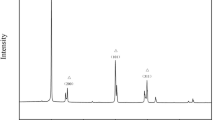Abstract
Hardness of ceramics is normally expressed by the size of the indent made by pressing a diamond indenter against the ceramic surface. If the indenter has a square pyramidal shape, the Vickers hardness is expressed as P/S, where the load is P and the surface area of the indent is S, and the unit is GPa. The Knoop hardness is measured by a rhombic-based pyramidal indenter, but the Vickers hardness is more popular. When a solid is stressed (force/area), the solid is deformed in accordance with Hooke’s law, which is expressed as (stress) = (elasticity) × (deformation). Strictly speaking, an isotropic solid has two independent elastic moduli. For example, if tensile stress is applied to a bar, it elongates in the same direction as the applied force. The elasticity (Young’s modulus, E) is obtained by dividing the stress by the deformation (elongation/length). The other is Poisson’s ratio (ν) which is the ratio of shrinkage in the direction normal to the direction of the elongation (Fig. 5.1). The shear modulus (or modulus of rigidity) and the bulk modulus of elasticity that affect shearing stress and volume compression, respectively, are other elastic moduli, but they can be calculated using the Young’s modulus and the Poisson’s ratio. The elastic coefficient of a material is calculated by measuring the deformation by bending tests and tensile tests or by measuring sonic speed of a material. The values obtained are called the static (isothermal) elasticity and dynamic (adiabatic) elasticity, respectively. E and ν of ceramics are 100–400 GPa and about 0.2, respectively.
Access this chapter
Tax calculation will be finalised at checkout
Purchases are for personal use only
Similar content being viewed by others
Notes
- 1.
Note 5.1 According to Griffith, strength σ = (2γE/πα)1/2, γ: surface energy, E: Young’s modulus, α: length of crack.
- 2.
Note 5.2 Expressed by stress intensity factor K = Yσ(pα)1/2, Y: shape factor, σ: external stress, α: length of crack.
- 3.
Note 5.3 This phenomenon is called polarization, and electrical dipoles are generated under this condition. Electrical dipoles indicate a pair of positive and negative electric charges separated by a certain distance.
Literature
Nishida T, Yasuda E (1986) Dynamic property evaluation of ceramics. Nikkan Kogyo Shimbun, Tokyo [in Japanese] (5.1)
Nakazawa H, Kobayashi H (1976) Strength of solid bodies. Kyoritsu Shuppan, Tokyo [in Japanese] (5.1)
Okamura H (1976) Introduction to linear fracture mechanics. Baifukan [in Japanese] (5.1)
Nakamura T (1984) Ceramics and heat. Gihodo Shuppan, Tokyo, pp 1–101 [in Japanese] (5.2)
The Japan Society of Thermophysical Properties (ed) (1990) Thermophysical property handbook. Yokendo, Tokyo [in Japanese] (5.2)
Kittel C (2005) Introduction to solid state physics, 8th edn. (5.2)
Sakka S (ed) Dictionary for understanding of ceramics. Agne, Tokyo, p 337 [in Japanese] (5.3)
Mook NK (1982) 12 new material encyclopedia. Nikkan Kogyo Shimbun, Tokyo, p 88 [in Japanese] (5.3)
The Chemical Society of Japan (ed) (1984) Designing of functional ceramics. Japan Scientific Societies Press, Tokyo, pp 25, 76 [in Japanese] (5.3)
Kreuer KD (2002) Chem Phys Chem 3:771 (5.4)
Supervised by Tamura H, Sato M (2003) Next-generation lithium secondary battery, NTS, Tokyo, p 312 [in Japanese] (5.4)
Chikazumi S. Physics of magnetic materials, Shokabo [in Japanese] (5.5)
The Laser Society of Japan (ed) (1982) Laser handbook. Ohmsha, Tokyo [in Japanese] (5.6)
Author information
Authors and Affiliations
Consortia
Rights and permissions
Copyright information
© 2012 Springer Japan
About this chapter
Cite this chapter
The Ceramic Society of Japan. (2012). Characteristics of Ceramics. In: Advanced Ceramic Technologies & Products. Springer, Tokyo. https://doi.org/10.1007/978-4-431-54108-0_5
Download citation
DOI: https://doi.org/10.1007/978-4-431-54108-0_5
Published:
Publisher Name: Springer, Tokyo
Print ISBN: 978-4-431-53913-1
Online ISBN: 978-4-431-54108-0
eBook Packages: Chemistry and Materials ScienceChemistry and Material Science (R0)




